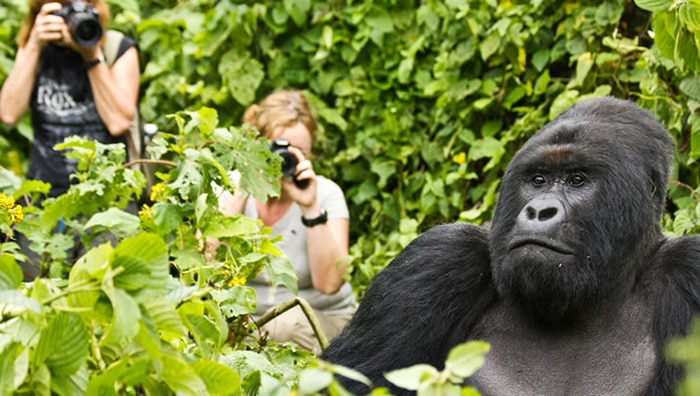Gorilla trekking is a popular activity that involves hiking through dense forests to observe and interact with gorillas in their natural habitat. As tourists are up close and personal with these incredible animals, they must follow specific safety protocols.
This article will delve deeper into gorilla trekking and give you a better understanding of how it can be done ethically and sustainably.
What Happens on a Gorilla Trek?
On a gorilla trek, tourists can expect to see various aspects of gorilla behavior. Mountain gorillas live in family groups led by a dominant male who makes decisions, mediates conflicts, and ensures group safety.
Tourists might witness grooming sessions, which reinforce social bonds among group members. Juvenile gorillas play together, engaging in activities like wrestling, which help them develop important skills.

Feeding is another significant activity frequently observed on gorilla treks. Many tourists enjoy watching these animals feast on foods like leaves and shoots. Vocalizations, such as grunts and roars, are also commonly heard. These are used for in-group communication.
Elena Less with Cleveland Metroparks Zoo says, “Grunts and grumbles are the most common noises,” and that, while grunts are short, grumbles are more drawn out and can vary in pitch.
Gorilla Trekking Etiquette For Tourists
Seeing gorillas in the wild can be exhilarating, especially for first-timers. However, it’s essential to keep some basic tips in mind to ensure your safety and that of the animals you’re observing.
DO: Follow Your Guide’s Lead
Good gorilla trekking etiquette involves following your guide’s instructions. They have extensive experience and knowledge about gorillas and their behavior. Their main priority is keeping tourists safe while allowing the animals to do their business undisturbed.

DON’T: Make Direct Eye Contact
Even the subtlest gestures can mean something to a gorilla. Direct and prolonged eye contact can be perceived as a challenge or threat. If a gorilla looks at you, quickly avert your gaze to avoid any conflicts.
DO: Keep a Safe Distance
Stay at least 7 meters (about 23 feet) away from gorillas. This minimizes the risk of disease transmission, which can be fatal to them. It may also put them at ease.
DON’T: Attempt to Touch the Gorillas
While it may be tempting, avoid touching the animals. Even if they come close, resist the urge to pet them. Human contact can transmit diseases and cause gorillas unnecessary stress.
DO: Crouch Down if Approached
If a gorilla comes closer, make yourself appear smaller by crouching or sitting down. This is a non-threatening posture and can help defuse any potential confrontation.

DON’T: Mimic Gorilla Sounds
Even with the best intentions, mimicking gorilla sounds can send misleading signals and cause confusion or agitation. Keep your voice down.
The Importance of Responsible Gorilla Trekking
Gorillas are classified as endangered due to habitat loss, poaching, and disease. Responsible gorilla trekking in countries like Uganda and Rwanda is crucial in their conservation. The revenue generated from tourism directly funds protection efforts, anti-poaching patrols, and habitat conservation.

Tourism heightens global awareness and advocacy for their preservation by fostering a connection between visitors and gorillas. Discover Africa Safaris ensures ethical wildlife tourism and works with each traveler to customize a tailored trip for their needs.
Book your gorilla trekking safari with us today.
Author: Alice Lombard
Published:
Part of the Uganda Safari, Kenya Safari & Mountain Gorilla Trekking Collections